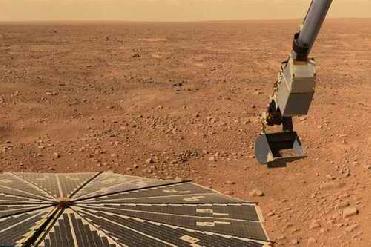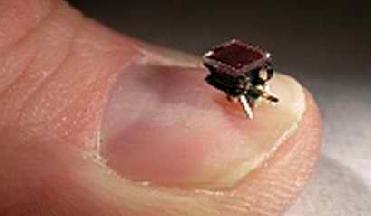
NASA's Phoenix Mars Lander's solar panel and the lander's Robotic Arm with a soil sample in the scoop
WASHINGTON (BNS): In a race against time and the elements, engineers with NASA's Phoenix Mars Lander mission hope to extend the Lander's survival by gradually shutting down some of its instruments and heaters, starting today.
Originally scheduled to last 90 days, Phoenix has completed a fifth month of exploration in the Martian arctic. As expected, with the Martian northern hemisphere shifting from summer to fall, the Lander is generating less power due to shorter days and fewer hours of sunlight reaching its solar panels. At the same time, the spacecraft requires more power to run several survival heaters that allow it to operate even as temperatures decline.
"If we did nothing, it wouldn't be long before the power needed to operate the spacecraft would exceed the amount of power it generates on a daily basis," said Phoenix Project Manager Barry Goldstein of NASA's Jet Propulsion Laboratory, Pasadena, California. "By turning off some heaters and instruments, we can extend the life of the Lander by several weeks and still conduct some science."
Over the next several weeks, four survival heaters will be shut down, one at a time, in an effort to conserve power. The heaters serve the purpose of keeping the electronics within tested survivable limits. As each heater is disabled, some of the instruments are also expected to cease operations. The energy saved is intended to power the Landerís main camera and meteorological instruments until the very end of the mission.
Later today, engineers will send commands to disable the first heater. That heater warms Phoenix's robotic arm, robotic-arm camera, and thermal and evolved-gas analyzer (TEGA), an instrument that bakes and sniffs Martian soil to assess volatile ingredients. Shutting down this heater is expected to save 250 watt-hours of power per Martian day.
The Phoenix team has parked the robotic arm on a representative patch of Martian soil. No additional soil samples will be gathered. The thermal and electrical-conductivity probe (TECP), located on the wrist of the arm, has been inserted into the soil and will continue to measure soil temperature and conductivity, along with atmospheric humidity near the surface. The probe does not need a heater to operate and should continue to send back data for weeks.
Throughout the mission, the Landerís robotic arm successfully dug and scraped Martian soil and delivered it to the onboard laboratories. "We turn off this workhorse with the knowledge that it has far exceeded expectations and conducted every operation asked of it," said Ray Arvidson, the robotic arm's co-investigator, and a professor at Washington University, St. Louis.
When power levels necessitate further action, Phoenix engineers will disable a second heater, which serves the Landerís pyrotechnic initiation unit. The unit hasn't been used since landing, and disabling its heater is expected to add four to five days to the mission's lifetime. Following that step, engineers would disable a third heater, which warms Phoenix's main camera -- the Surface Stereo Imager Ėand the meteorological suite of instruments. Electronics that operate the meteorological instruments should generate enough heat on their own to keep most of those instruments and the camera functioning.
In the final step, Phoenix engineers may turn off a fourth heater -- one of two survival heaters that warm the spacecraft and its batteries. This would leave one remaining survival heater to run out on its own.
"At that point, Phoenix will be at the mercy of Mars," said Chris Lewicki of JPL, lead mission manger.
Engineers are also preparing for solar conjunction, when the sun is directly between Earth and Mars. Between November 28 and December 13, Mars and the sun will be within two degrees of each other as seen from Earth, blocking radio transmission between the spacecraft and Earth. During that time, no commands will be sent to Phoenix, but daily downlinks from Phoenix will continue through NASA's Odyssey and Mars Reconnaissance orbiters. At this time, controllers can't predict whether the fourth heater would be disabled before or after conjunction.
 Previous Article
Previous Article Next Article
Next Article













The Indian Air Force, in its flight trials evaluation report submitted before the Defence Ministry l..
view articleAn insight into the Medium Multi-Role Combat Aircraft competition...
view articleSky enthusiasts can now spot the International Space Station (ISS) commanded by Indian-American astr..
view article